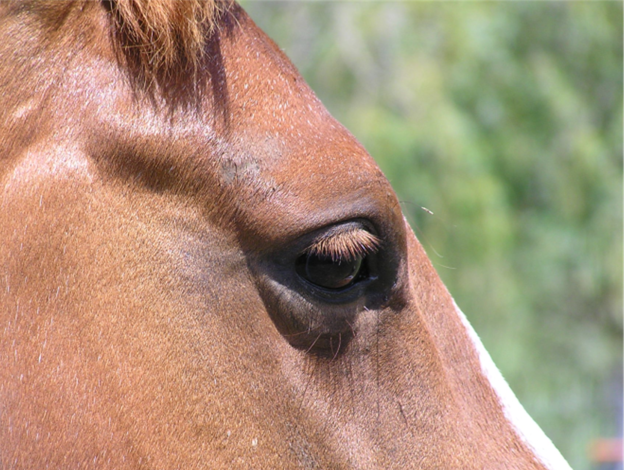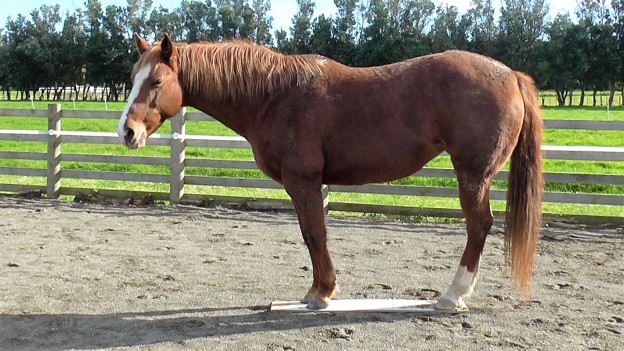In the photo above, Boots noticed that Bridget has the hoofpick and spray bottle in her hand, so she knows it is foot care time, and offers her foot.
‘All behaviors rest on an emotional ediface.’ I don’t know the source of this quote, but it underpins just about everything.
Our aim is to have the horse confidently lift each foot on signal and keep it up for as long as we need it.
- Work in a space familiar to the horse, where he is usually relaxed; buddies in view but not able to interfere. Horse is not hungry.
- Horse at liberty or wearing halter and lead (not tied up). Halter and lead allow us to help him stand square. If the horse can’t stand quietly without being tied, that is a skill to work on first. A familiar mat gives the horse a destination spot for standing quietly. See Number 9 in the Blog Contents Quick Links ( at top of page) if you need to establish confident parking on a mat first.
- Ensure the horse is warmed up a bit so it is easier for him to stand on three legs.
- Ensure the horse is in a learning frame of mind. If not, encourage activity to use up adrenalin or do relaxing activities he knows well before starting.
It pays to remember that if you are nervous about picking up a horse’s foot, your anxiety pales into insignificance compared with how worried a horse might be if he has not been introduced to foot care with thought to his feelings.
Some horses may have had a bad experience with a particular leg. Be aware that a reluctance to lift a foot, or keep it up, can be due to pain from an old injury, current sore muscles/joints and/or arthritis.
Horses know that if their feet are compromised, they are close to death. It pays to teach ‘picking up feet’ carefully and thoroughly and not leave it to other people. By going through all the steps outlined below, we can also overcome our own natural fear and anxiety about getting hurt.
Our first job is to make sure we can rub and massage the front legs down to the heel with the horse able to stand still in a relaxed manner, totally confident that we are not going to hurt him. With some horses, to keep everything safe and low key, it’s a good idea to use a body extension to rub the legs. We can keep our body erect, stay relaxed, and use a high rate of reinforcement. If we are tense, the horse will be tense.

I’m using a pool noodle to get the horse used to having things rubbed on her legs, the back and front of each leg as well as up and down.
The rate of reinforcement must allow the horse to be continually successful. At first it might be a barely touch of the body extension to a front leg. We start where the horse is, and work forward from that point. See Number 5 in the Blog Contents Quick Links (link at the top of the page) for The Four Stages of Learning.
Use advance and retreat. That means start up high and move down a leg until one of you feels uncomfortable. When you reach either you or the horse’s threshold of comfort, retreat by moving back up to the withers, relax, then advance again. This is called a re-set. You know you have reached a threshold if you feel tension in the horse’s body or you begin to feel anxious or uncomfortable.
Every time we do a re-set, we have a new opportunity to clarify our signal and our intent.
The mindmap below looks at the the tasks involved with front foot hoof care. Note that the first stage, rubbing the length of the leg, is omitted – my mistake.

Stand Square: the prerequisite task of stepping forward and backward, one step at a time, ensures that the horse understands our request to stand squarely. It helps if we routinely ask for square halts in a variety of situations. Each square or almost square halt, on request, earns a click&treat.
Using a mat makes it easier because, as the mat-savvy horse approaches the mat, he knows he will halt with his front feet on the mat. In other words, he has time to mentally and physically prepare himself and often halts squarely to earn his click&treat. Remember, he has four limbs to organize!
When asking the horse to square up, slightly tilt his head away from the front foot you want him to move. Moving his head away frees up the shoulder so he can move the leg.
Knee-Lifts to Touch a Target
Always start by asking the horse to stand squarely. This will help him remain balanced when he lifts a leg.
If we touch a target item gently to the front of the horse’s knee, accompanied by a click&treat, most clicker-savvy horses will quickly learn to raise the knee to touch the target. First, touch it to his knee, click& treat. When that is well established, hold the target a little tiny bit above the knee. He will work out that raising his knee touches the target and earns a click&treat. If he doesn’t, go back to touching the knee gently, click&treat until he makes the connection.
A pool noodle, a plastic bottle attached to a light stick (e.g. bamboo), or a light stick with bubble wrap taped around it, are the sorts of items we can use for knee targets.
#89 HorseGym with Boots demonstrates. Work with just the front feet until you are both totally solid with them. More detail about hind feet will be in the next blog.
Front Feet
If you’ve taught your horse to target his knee to your hand when you stand near him, facing him, he will have already shifted his weight so he can lift his foot, and you can catch hold of his foot while it is in the air.
Some people choose to touch the chestnut as a signal for lifting the foot. If you start with your hand at the withers each time, the horse will most likely soon learn to shift his weight and be already lifting his foot when you reach the chestnut.
It can be handy to teach a concurrent verbal signal such as, ‘Lift’. This is also helpful when we ask the horse to step cleanly over a rail, forwards and backwards.
Before we can gain the horse’s confidence about trusting his foot to our care, we must build up our own confidence. The best way is to do it in short, 3-minute segments, working through a series of thin-sliced questions that might look like the list below for the front feet.
As you play with the slices listed below, you will be collecting feedback on how you feel about each slice, and how your horse feels about each slice. You stay with each slice until the answer to the question is, ‘Yes.’
Remember, warmed up muscles will find the strain of standing on three legs and holding up a leg easier.
The rate of reinforcement must allow the horse to be continually successful with what you are asking.
- Can I: gently & confidently rub his leg & foot all over with my body extension (stick, pool noodle)? If you can, practice on an experienced horse (or practice on a person) to get the feel for it, if this is new to you.
- Will my horse: let me rub his leg and foot with my body extensions? Make sure he is already comfortable with being rubbed over the rest of his body.
- Can I: confidently rub his leg & foot with my hand? Start at his withers and rub down only as far as you feel comfortable at that time. Over many tiny sessions, you will get the confidence to rub all the way down.
- Will my horse: let me rub his leg and foot with my hand?
- Can I: get him to stand so he is balanced before I want to pick up a foot? Have I taught him how to line up squarely to target his front feet to a mat, and/ormove forward and back one step at a time? If not, you want to teach that first.
- Will my horse pick up a foot when I ask him to target my hand with his knee … OR slices 7.-9.
- Will my horse: take the weight off his right front leg when I run my hand from his withers and down his leg?
- Can I: confidently ask him to pick up his foot by touching his chestnut?
- Will my horse: pick up his foot when I touch the the chestnut?
- Can my horse: keep his balance okay standing on three legs?
- Will my horse: let me hold his foot for one second before I release it back to the ground? (Click just before you release, then move to his head to deliver the treat.)
- Can I: let my hand and arm holding the foot swing freely with any movement the horse makes with his leg until it stops swinging, at which point I click, gently release the foot and move forward to deliver the treat? (I do this only if I’m feeling safe.) If you feel whole body tension in the horse wanting his foot back, I would release the foot and work on earlier steps. The horse has an emotional block somewhere and we need to winkle it out. (All behaviors rest on an emotional ediface.)
- Will my horse: gradually let me hold the foot longer and longer (one second at a time) and stay relaxed until I click&treat?
- Will my horse: hold his foot up in a relaxed way for as long as I need it up, waiting for the click&treat?

Boots is targeting her knee to my hand. For the next slice, I would change my body orientation to stand beside her shoulder so when she lifts her foot it is easy for me to ‘catch’ it in my hand.

I build duration of keeping the foot up one second at a time, before I release it gently, followed by a click&treat.

It’s also possible to build duration by reaching back to deliver the treat while holding up the foot. Some people set up a raised tub into which they can toss the treat.
To Make Your Job Much Easier…..
Check out Number 59 in the Blog Contents Quick Links (see top of page), for Counting with the Front Feet. This exercise has the added benefit of developing the horse’s skill of organising his weight to stand on three legs, to a high level.









































































